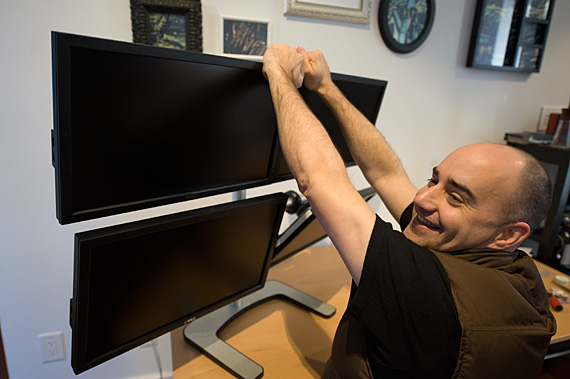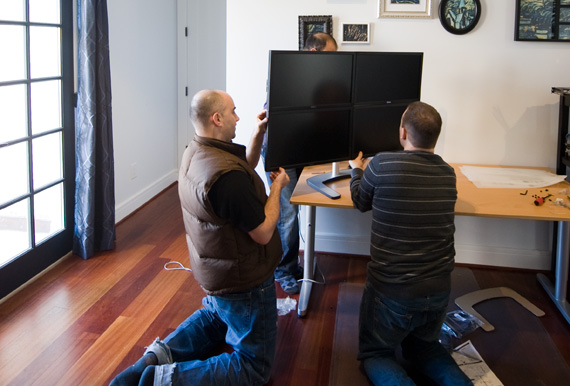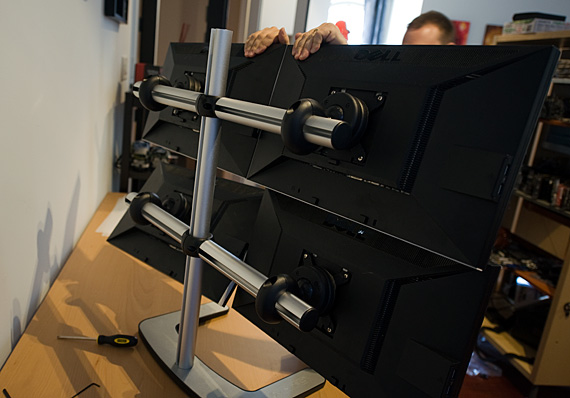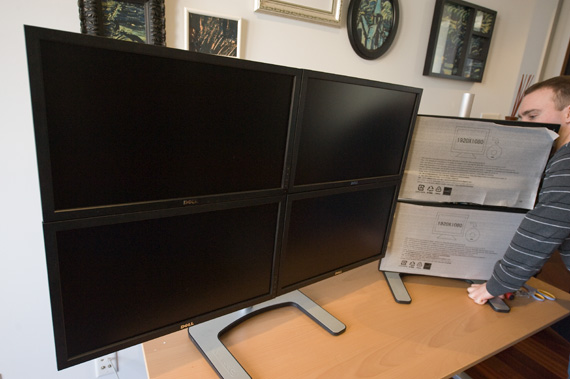AMD's Radeon HD 5870 Eyefinity 6 Edition Reviewed
by Anand Lal Shimpi on March 31, 2010 12:01 AM EST- Posted in
- GPUs
Completing the Eyefinity 6 Build
Just when we thought we were good to go with the first four panels, we heard a loud snap and a whole lot of bad ensued. The tape we applied earlier made it look like the panels were happily resting against one another but in reality it was just barely holding together a contraption that did not want to be contained any longer.
Apparently we hadn't adjusted all of the mounts properly and eventually the tape gave way (hence it not being magic sticky tape):

Here we have AMD's Chris Hook holding two panels together while I tighten the mounts to hopefully keep them in place. I believe I'm telling him a funny story at this point as well.

Setting up one of these Eyefinity 6 builds is definitely a two person job, and I wouldn't shy away from having a third join in. It definitely helped us.

Luckily Atdec's two display stand was much easier to assemble. You just adjust the vertical position of the arms that will hold your two displays, and with that done just clamp them into place. We lined up the two remaining displays to our slanty 4 monitor setup and things started to come together:

The whole process took a couple of hours. It would've taken more if we cared about trying to get all of the bezels to line up perfectly. If you've got a friend (or ten) who have great attention to detail and are extremely patient with assembling things, invite them over to help setup your $1500 Eyefinity 6 display (you should probably bake them a cake).

The finished product definitely had issues. The tape didn't keep the panels together forever. I will say that the gaps between the bezels didn't bother me that much, although the combined thickness of two bezels was annoying when actually using the system.










78 Comments
View All Comments
frenchfrog - Wednesday, March 31, 2010 - link
It would be so nice:-3 monitors for left-center-rigth views
-1 monitor for rear view
-2 monitors for guages/GPS/map/flight controls
vol7ron - Wednesday, March 31, 2010 - link
I'm not sure why a "wall" was created. Your problem with FOV is the fact that you have too much of a 2D setup, rather than an easier-to-view 3D.Suggestion: 3 stands.
Center the middle pair to your seat.
Adjust the right and left pair so they're at a 15-25 degree slant, as if you were forming a hexadecagon (16 sided polygon @ 22.5 degrees)
vol7ron
cubeli - Wednesday, March 31, 2010 - link
I cannot print your reviews anymore.. Any help would be greatly appreciated!WarlordSmoke - Wednesday, March 31, 2010 - link
I still don't understand the point of this card by itself, as a single card(no CF).It's too expensive and too gaming oriented to be used in the workplace where, as someone else already mentioned, there have been cheaper and more effective solutions for multi-display setups for years.
It's too weak to drive the 6 displays it's designed to for gaming. Crysis(I know it's not a great example of an optimized engine but give me a break here) which is a 3 year old game isn't playable at < 25fps and I can't imagine the next generation of games which are around the corner to be more forgiving.
My point is, why build a card to drive 6 displays when you could have 2 cards that can drive 3 displays each and be more effective for gaming. I know this isn't currently possible, but that's my point, it should be, it's the next logical step.
Instead of having 2 cards in crossfire, where only one card has display output and the other just tags along as extra horsepower, why not use the cards in parallel, split the scene in two and use two framebuffers(one card with upper 3 screens and the other card with the lower 3 screens) and practically make crossfire redundant(or just use it for synchronizing the rendering).
This should be more efficient on so many levels. First, the obvious, half the screens => half the area to render => better performance. Second, if the scene is split in two each card could load different textures so less memory should be wasted than in crossfire mode where all cards need to load the same textures.
I'm probably not taking too seriously the synchronization issues that could appear between them, but they should be less obvious when they are between distinct rows of displays, especially if they have bezels.
Anyway this idea with 2 cards with 3 screens each would have been beneficial to both ATI(sales of more cards) and to the gamers: Buy a card and three screens now, and maybe later if you can afford it buy another card and another three screens. Not to mention the fact that ATI has several distinct models of cards that support 3 displays. So they could have made possible 6 display setups even for lower budgets.
To keep a long story short(er), I believe ATI should have worked to make this possible in their driver and just scrap this niche 6 display card idea from the start.
Bigginz - Wednesday, March 31, 2010 - link
I have an idea for the monitor manufacturers (Samsung). Just bolt a magnifying glass to the front of the monitor that is the same width and height (bezel included). I vaguely remember some products similar to this for the Nintendo Gameboy & DS.Dell came out with their Crystal LCD monitor at CES 2008. Just replace the tempered glass with a magnifying glass and your bezel problem is fixed.
http://hothardware.com/News/Dell_Crystal_LCD_Monit...
Calin - Thursday, April 1, 2010 - link
Magnifying glass for such a large surface would be thick and heavy (and probably prone to cracking), and "thin" variations have image artefacts (I've seen a magnifying "glass" usable as a bookmark, and the image was good, but it definitely had issuesimaheadcase - Wednesday, March 31, 2010 - link
As much R&D the invested in this, It seems better to use it towards making own monitors that don't have bezels. The extra black link is a major downside to this card.ATI monitors + video setup would be ideal. After all, when you are going to drop $1500 + video card setup, what is a little more in price for a streamlined monitors.
yacoub - Wednesday, March 31, 2010 - link
"the combined thickness of two bezels was annoying when actually using the system"Absolutely!
CarrellK - Thursday, April 1, 2010 - link
There are a fair number of comments to the effect of "Why did ATI/AMD build the Six? They could have spent their money better elsewhere..." To those who made those posts, I respectfully suggest that your thoughts are too near-term, that you look a bit further into the future.The answers are:
(1) To showcase the technology. We wanted to make the point that the world is changing. Three displays wasn't enough to make that point, four was obvious but still not enough. Six was non-obvious and definitely made the point that the world is changing.
(2) To stimulate thinking about the future of gaming, all applications, how interfaces *will* change, how operating systems *will* change, and how computing itself is about to change and change dramatically. Think Holodeck folks. Seriously.
(3) We wanted a learning vehicle for ourselves as well as everyone else.
(4) And probably the biggest reason of all: BECAUSE WE THOUGHT IT WOULD BE FUN. Not just for ourselves, but for those souls who want to play around and experiment at the edges of the possible. You never know what you don't know, and finding that out is a lot of fun.
Almost every day I tell myself and anyone who'll listen: If you didn't have fun at work today, maybe it is time to do something else. Go have some fun folks.
Anand Lal Shimpi - Thursday, April 1, 2010 - link
Thanks for posting Carrell :) I agree with the having fun part, if that's a motivation then by all means go for it!Take care,
Anand